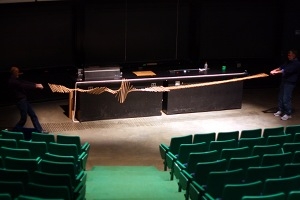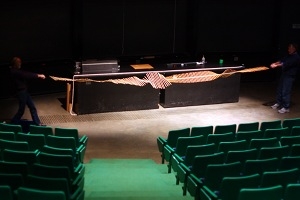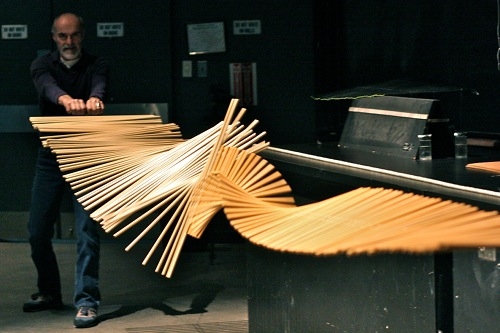Large (20 feet long) Shive wave machine that can clearly show the reflection and transmission of a pulse at the boundary of fast and slow media.
What it shows:
Being so large (20 feet long), transverse traveling waves on this apparatus are easily seen by a large audience. The propagation speed of the waves is much slower than on the Shive Wave Machine, giving the audience time to process what's going on. The apparatus can be used to show three properties of waves: (1) wave speed is inversely proportional to the square root of the medium's inertia, (2) waves traveling from a fast medium to a slow medium are partially reflected at the interface and the reflection undergoes a phase change; waves traveling from a slow to a fast medium are also partially reflected but do not suffer a phase change. (3) The wavelength increases when traveling in the fast medium and decreases when traveling in the slow medium.
 |
 |

How it works:
The transverse wooden dowel wave machine consists of 80 1-foot long dowels and 80 2-foot dowels suspended in the middle by two closely spaced nylon lines. The nylon lines pass through handles at each end; two people are needed to hold the wave machine by these handles and keep it under tension. Giving the handle a momentary 90 degree twist sends a torsional wave down the length of the apparatus.
(1) Generally speaking, the wave velocity is proportional to the square root of the ratio of the stiffness of the medium to the inertia of the medium.

In this case the stiffness is the restoring torque that brings the displaced dowels back to their equilibrium position; its magnitude depends on the tension in the supporting nylon lines and their separation, both of which are constant along the entire length. The inertia of the medium is the rotational inertia of the dowels (about their middle) and is equal to (1/12)mL2. Doubling the length of a dowel also doubles its mass, so the rotational inertia of the 2-ft long dowels is eight times the rotational inertia of the 1-ft long dowels. The wave velocity is thus a factor = square root of 8 = 2.8 slower in the longer dowel section. This is almost a factor of three and is easily verified: a pulse launched at the short-dowel end reaches the middle of the apparatus in about 2 seconds; the pulse continues and takes a little bit less than 6 seconds to travel the second half of its journey through the long dowels.
(2) Whenever a wave enters a medium in which the wave velocity is lower than the incident medium, there will be a partial reflection of that wave at the interface between the two mediums and the reflection will suffer a 180˚ phase change (i.e., the reflected wave is inverted with respect to the incident wave). On the other hand, if the wave travels from a slow to a fast medium, the reflection does not suffer a phase change and is not inverted. These two kinds of reflections are readily visible on this apparatus when the two people holding the apparatus alternately launch pulses.
Additionally, one can demonstrate what happens if there is an impedance mismatch within an otherwise uniform medium. One can attach steel machine nuts to the ends of a couple of adjacent dowels in either the middle of the "fast" medium or "slow medium." That, of course, increases the rotational inertia of those dowels and creates an impedance mismatch at that location. Part of the energy of a traveling pulse consequently gets reflected at that location, and part is transmitted—the percentage of reflection and transmission depending on the magnitude of the impedance mismatch. That can be adjusted by changing the number of nuts on the end of the dowel.
(3) Finally, we pay attention to the nature of the transmitted wave. It does not get inverted in traveling from one medium to the other, but the wavelength changes. When the wave gets slowed down, the wavelength clearly shortens in the slow medium and the opposite is of course true for the fast medium.
Setting it up:
At least 20 feet of clear floor space is needed. For efficiency, the wave apparatus will be laid on the floor ready for use in during the lecture. Obviously the lecturer will need a second person to hold the other end. It needs to be held quite taught and you should practice beforehand to get the hang of it (as it were). The nylon line is monofilament rated at 100 lb test strength. Since two such lines hold the dowels, we don't anticipate it breaking.
Comments and details:
The present wave machine is a modification of one described by Dr. Cyril Isenberg in his publication "Experiments with Waves," (Cochranes of Oxford, England). That version consisted of just 80 1-ft long dowels. The birch dowels are 3/8" in diameter. Two small holes for the monofilament are centered about the middle of the dowel. The holes are spaced 5/8" apart and a #56 drill was used to accommodate the 1 mm diameter (≈ 0.040") line. The spacers between the dowels are plastic coffee stirrers cut into 1" lengths. The nuts used for increasing the rotational inertia are 7/16"-14 thread steel machine nuts. They fit nicely over the 3/8" dowels and can simply be taped in place.